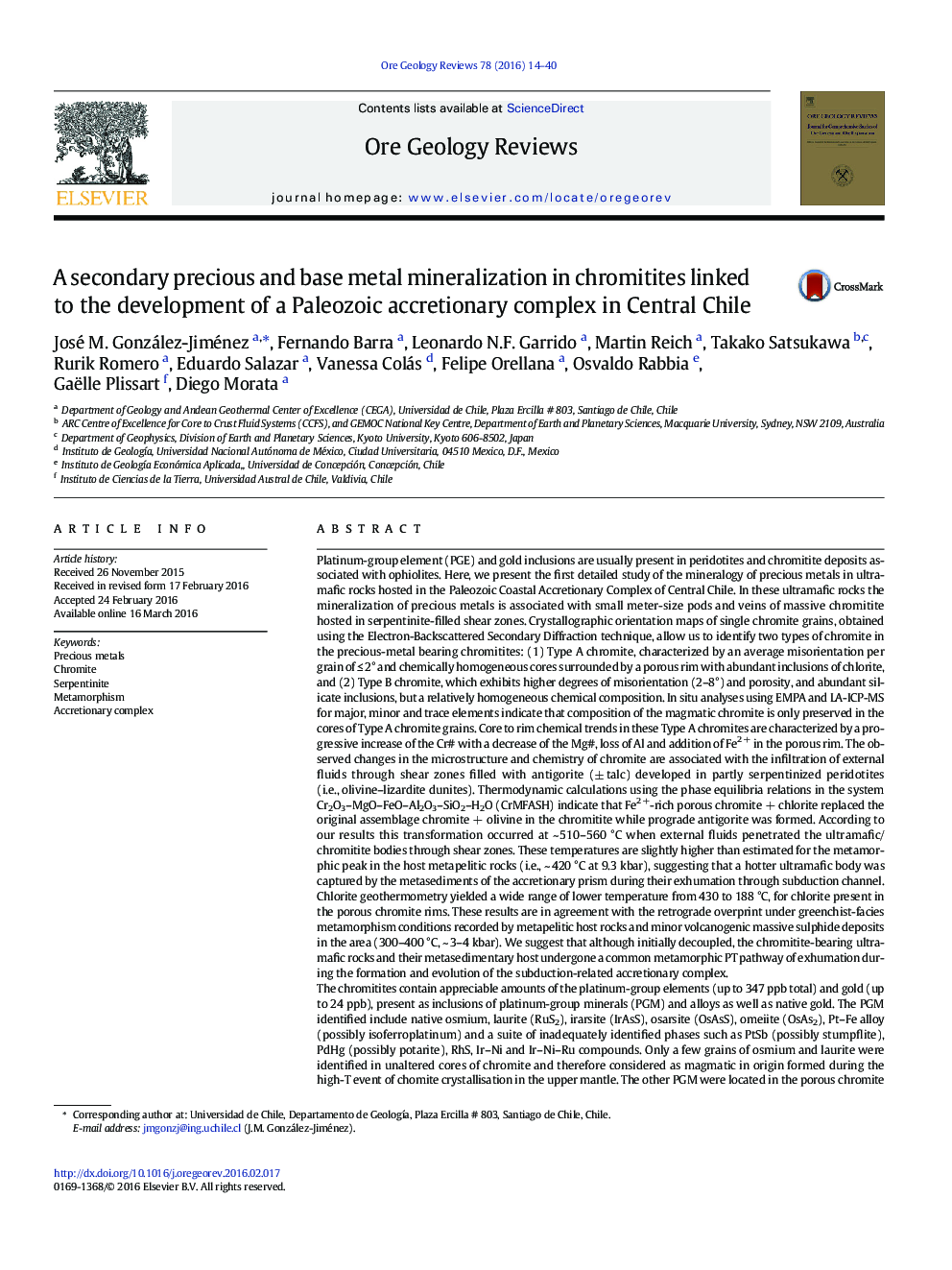| کد مقاله | کد نشریه | سال انتشار | مقاله انگلیسی | نسخه تمام متن |
|---|---|---|---|---|
| 4696837 | 1637228 | 2016 | 27 صفحه PDF | دانلود رایگان |

• We report the first detailed study of podiform chromitites associated with serpentinite shear zones in Chile
• Fluids released from metasediments during metamorphism produced alteration of chromite
• The mineralization of precious and base metals is associated with metamorphism
• A metamorphic evolution of the chromite ores is linked to the development of a Paleozoic accretionary complex during the Paleozoic
Platinum-group element (PGE) and gold inclusions are usually present in peridotites and chromitite deposits associated with ophiolites. Here, we present the first detailed study of the mineralogy of precious metals in ultramafic rocks hosted in the Paleozoic Coastal Accretionary Complex of Central Chile. In these ultramafic rocks the mineralization of precious metals is associated with small meter-size pods and veins of massive chromitite hosted in serpentinite-filled shear zones. Crystallographic orientation maps of single chromite grains, obtained using the Electron-Backscattered Secondary Diffraction technique, allow us to identify two types of chromite in the precious-metal bearing chromitites: (1) Type A chromite, characterized by an average misorientation per grain of ≤ 2° and chemically homogeneous cores surrounded by a porous rim with abundant inclusions of chlorite, and (2) Type B chromite, which exhibits higher degrees of misorientation (2–8°) and porosity, and abundant silicate inclusions, but a relatively homogeneous chemical composition. In situ analyses using EMPA and LA-ICP-MS for major, minor and trace elements indicate that composition of the magmatic chromite is only preserved in the cores of Type A chromite grains. Core to rim chemical trends in these Type A chromites are characterized by a progressive increase of the Cr# with a decrease of the Mg#, loss of Al and addition of Fe2 + in the porous rim. The observed changes in the microstructure and chemistry of chromite are associated with the infiltration of external fluids through shear zones filled with antigorite (± talc) developed in partly serpentinized peridotites (i.e., olivine–lizardite dunites). Thermodynamic calculations using the phase equilibria relations in the system Cr2O3–MgO–FeO–Al2O3–SiO2–H2O (CrMFASH) indicate that Fe2 +-rich porous chromite + chlorite replaced the original assemblage chromite + olivine in the chromitite while prograde antigorite was formed. According to our results this transformation occurred at ~ 510–560 °C when external fluids penetrated the ultramafic/chromitite bodies through shear zones. These temperatures are slightly higher than estimated for the metamorphic peak in the host metapelitic rocks (i.e., ~ 420 °C at 9.3 kbar), suggesting that a hotter ultramafic body was captured by the metasediments of the accretionary prism during their exhumation through subduction channel. Chlorite geothermometry yielded a wide range of lower temperature from 430 to 188 °C, for chlorite present in the porous chromite rims. These results are in agreement with the retrograde overprint under greenchist-facies metamorphism conditions recorded by metapelitic host rocks and minor volcanogenic massive sulphide deposits in the area (300–400 °C, ~ 3–4 kbar). We suggest that although initially decoupled, the chromitite-bearing ultramafic rocks and their metasedimentary host undergone a common metamorphic PT pathway of exhumation during the formation and evolution of the subduction-related accretionary complex.The chromitites contain appreciable amounts of the platinum-group elements (up to 347 ppb total) and gold (up to 24 ppb), present as inclusions of platinum-group minerals (PGM) and alloys as well as native gold. The PGM identified include native osmium, laurite (RuS2), irarsite (IrAsS), osarsite (OsAsS), omeiite (OsAs2), Pt–Fe alloy (possibly isoferroplatinum) and a suite of inadequately identified phases such as PtSb (possibly stumpflite), PdHg (possibly potarite), RhS, Ir–Ni and Ir–Ni–Ru compounds. Only a few grains of osmium and laurite were identified in unaltered cores of chromite and therefore considered as magmatic in origin formed during the high-T event of chomite crystallisation in the upper mantle. The other PGM were located in the porous chromite associated with chlorite or base-metal minerals (BMM) that often fill the pores of this altered chromite or are intergrowth with antigorite in the host serpentinized ultramafic rock. The assemblage of BMM identified in the studied rocks include sulphides [millerite (NiS), polydymite (Ni3S4), violarite (FeNi2S4), galena (PbS), sphalerite (ZnS), chalcocite (CuS)], arsenides [(orcelite (Ni5 − xAs2) and maucherite (Ni11As8)], the sulpharsenide gersdorfitte (NiAsS), and native bismuth. The irregular shape of several PGM grains observed in porous chromite suggest disequilibrium, whereas others exhibit perfectly developed crystal faces with the associated secondary silicate or base-metal mineral suggesting neoformation of PGMs in situ from metamorphic fluids. We suggest that the origin of these PGM inclusions is magmatic, but some grains were reworked in situ when metalloid (i.e., As, Sb, Pb, Zn and Hg)-rich fluids released from metasediments penetrated the ultramafic rocks through active shear zones, once the ultramafic bodies became tectonically mixed with the host metasedimentary host rocks. During this event, gold sourced from the (meta)sediments was also precipitated within chromitites and serpentinites.
Figure optionsDownload as PowerPoint slide
Journal: Ore Geology Reviews - Volume 78, October 2016, Pages 14–40